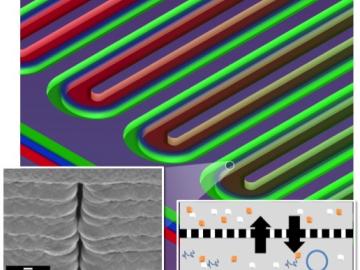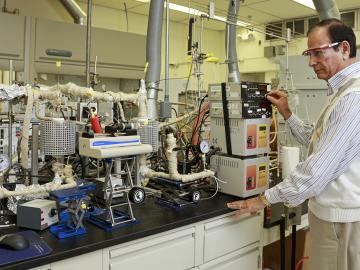Filter News
Area of Research
- (-) Clean Energy (42)
- (-) National Security (2)
- Advanced Manufacturing (4)
- Biological Systems (3)
- Biology and Soft Matter (1)
- Building Technologies (2)
- Chemical and Engineering Materials (2)
- Chemistry and Physics at Interfaces (6)
- Computational Chemistry (1)
- Energy Frontier Research Centers (7)
- Functional Materials for Energy (6)
- Fusion and Fission (1)
- Fusion Energy (1)
- Geographic Information Science and Technology (2)
- Isotope Development and Production (1)
- Isotopes (1)
- Materials (41)
- Materials Synthesis from Atoms to Systems (5)
- Materials Under Extremes (6)
- Neutron Data Analysis and Visualization (2)
- Neutron Science (11)
- Nuclear Science and Technology (6)
- Quantum Condensed Matter (2)
- Reactor Technology (1)
- Supercomputing (20)
- Transportation Systems (2)
Media Contacts
ORNL drone and geospatial team becomes first to map the Coca River in the Amazon basin as erosion and sediment threaten Ecuador’s lands.

Electric vehicles can drive longer distances if their lithium-ion batteries deliver more energy in a lighter package. A prime weight-loss candidate is the current collector, a component that often adds 10% to the weight of a battery cell without contributing energy.

Jack Orebaugh, a forensic anthropology major at the University of Tennessee, Knoxville, has a big heart for families with missing loved ones. When someone disappears in an area of dense vegetation, search and recovery efforts can be difficult, especially when a missing person’s last location is unknown. Recognizing the agony of not knowing what happened to a family or friend, Orebaugh decided to use his internship at the Department of Energy’s Oak Ridge National Laboratory to find better ways to search for lost and deceased people using cameras and drones.



Researchers at the Department of Energy’s Oak Ridge National Laboratory have received six R&D 100 Awards, increasing the lab’s total to 193 since the award’s inception in 1963. The competition, sponsored by R&D Magazine, recognizes advances in the nation’s ...

The Department of Energy’s Oak Ridge National Laboratory, FCA US LLC, and the foundry giant, Nemak of Mexico, are combining their strengths to create lightweight powertrain materials that will help the auto industry speed past the technological

A new study from the Department of Energy’s Oak Ridge National Laboratory explains the mechanism behind a technology that converts bio-based ethanol into hydrocarbon blend-stocks for use as fossil fuel alternatives. Scientists have experimented for decades with a cl...

Trane Commercial Systems and Oak Ridge National Laboratory have coaxed 20 percent greater performance out of a baseline commercial rooftop air conditioning unit with the potential for even better efficiency by switching refrigerants. Through a cooperative research and develo...





